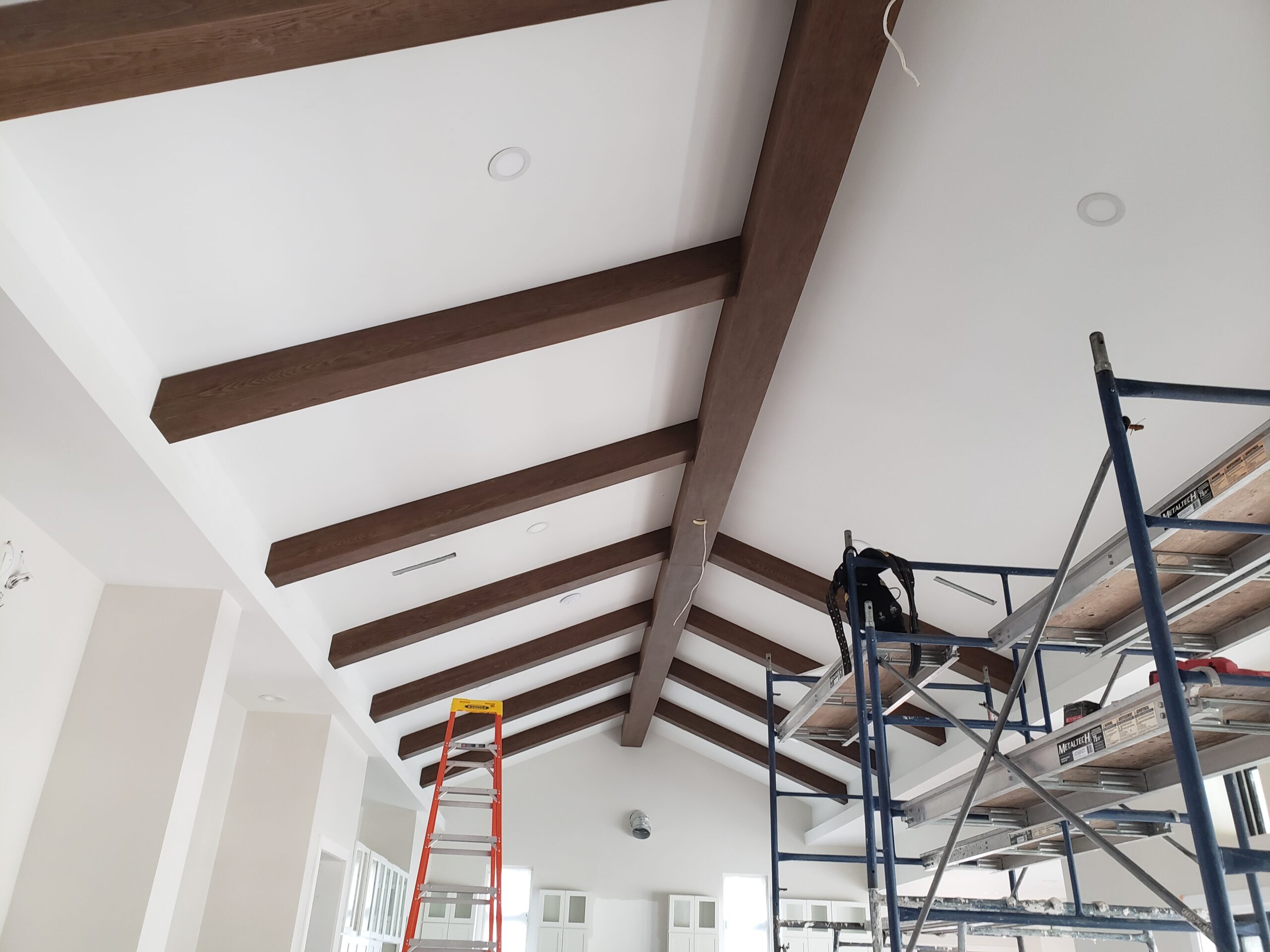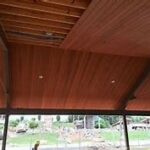Are you dreaming of an inviting, rustic ceiling that also keeps your home cozy? Tongue and groove ceiling panels may just be the answer! While these stylish ceilings add character to any room, ensuring they’re well insulated is key to maintaining a comfortable indoor temperature year-round and reducing those pesky energy bills.
The good news? Insulating a tongue and groove ceiling doesn’t have to be complicated.
In this guide, you’ll find everything you need to tailor your insulation project to your specific needs, whether you’re working with new construction or retrofitting an existing space. We’ll walk you through practical tips and techniques, helping you select the right materials and install them effectively to enhance both thermal efficiency and acoustic performance.
Get ready to master the art of tongue and groove ceiling insulation and transform your space into a warm, energy-efficient haven!
Choosing the Right Insulation Material for Tongue and Groove Ceilings
Selecting the right insulation material is crucial for maximizing the efficiency of your tongue and groove ceiling. With an array of options available, it can feel overwhelming, but focusing on a few key factors will simplify the decision.
Firstly, consider the R-value, which measures thermal resistance. Higher R-values offer better insulation and are essential for regions with extreme weather conditions. Fiberglass batts, for instance, are a popular choice due to their high R-value and affordability.
Next, think about installation ease and flexibility. spray foam insulation techniques are excellent for awkward spaces and hard-to-reach areas, expanding to fill gaps and provide a robust thermal barrier. Its higher cost can be offset by its superior performance and air sealing abilities.
Don’t forget acoustic properties, especially if your home is prone to noise. Mineral wool not only provides decent thermal resistance but also excels in soundproofing, making it perfect for bustling households.
Lastly, keep sustainability in mind. Natural options like sheep’s wool or cellulose offer eco-friendly alternatives that balance performance with environmental benefits.
Whichever material you choose, ensure it aligns with your specific needs and priorities for a comfortable, energy-efficient home.
Key Considerations Before Installing Insulation in Tongue and Groove Ceilings
Before diving into the installation, it’s essential to take stock of several important factors to ensure a smooth process and successful outcome. Proper preparation can save time and frustration later on.
Assessing Existing Conditions
First, assess the current condition of your ceiling. Look for any signs of moisture, as this can affect insulation performance and even lead to mold. Address leaks and ensure the space is dry and well-ventilated to prevent future issues.
Next, measure the space meticulously. Accurate measurements are crucial for buying the right amount of insulation and avoiding unnecessary waste.
Planning for Accessibility
Consider how you’ll access the installation area. Tongue and groove ceilings can sometimes be difficult to reach, especially in older or high-ceilinged homes. Ensure you have the necessary tools and equipment, like ladders or scaffolding, to work safely and effectively.
It’s also wise to plan around fixtures like lighting and fans. Decide whether these need to be temporarily removed or if there’s a strategy in place to work around them.
Lastly, remember that insulation should complement the aesthetic and structural integrity of the tongue and groove ceiling. Avoid compromising the charming design while still achieving efficient energy control.
Preparing the Ceiling Surface for Insulation
Getting the ceiling ready for insulation is a critical step you don’t want to skip. Adequate prep work ensures that the insulation performs effectively and lasts longer, saving you time and energy in the future.
Cleaning and Inspecting
Start by thoroughly cleaning the ceiling surface. Dust and debris can obstruct installation and reduce the adhesion of some insulation types, particularly spray foam. A clean surface also allows for a more comprehensive inspection to identify any areas that may need repair.
Check the integrity of the tongue and groove panels, looking for signs of damage such as warping or loose joints. Repair any problematic sections to maintain a tight seal and even surface for the insulation to adhere to.
Ensuring a Tight Seal
Remove old insulation if it exists and inspect for gaps or openings that could cause air leakage. Seal these with caulk or foam sealant to enhance the overall efficiency of the new insulation. If using batts or rolls, you might need to install a vapor barrier to protect against moisture, particularly in humid climates.
By dedicating time to proper preparation, you’re setting the stage for a successful installation that will keep your home comfortable and energy-efficient for years to come.
Ensuring Proper Ventilation to Prevent Moisture Build-Up
Proper ventilation is a key component in the success of your insulated tongue and groove ceiling. Without it, trapped moisture can lead to significant issues like mold and structural damage, compromising both comfort and safety.
Understanding Ventilation Needs
First, understand the balance between insulation and ventilation. While insulation retains heat, ventilation allows moisture-laden air to escape. This balance is crucial to prevent condensation within the ceiling cavity.
Evaluate your current ventilation system. Ensure there are adequate vents in the attic or roof space, such as ridge vents or gable vents, which allow for continuous airflow throughout the area. These vents help maintain an optimal temperature and humidity balance.
Installing Additional Ventilation
If necessary, consider adding additional ventilation. Baffle vents or soffit vents can be installed to enhance airflow without sacrificing insulation efficiency. Ensure vents remain unobstructed by insulation material, maintaining a clear path for air movement.
Remember, maintaining proper ventilation goes hand-in-hand with quality insulation. This duo not only protects the integrity of your tongue and groove ceiling but also enhances your home’s overall energy performance, providing a healthier living environment.
Effectively Installing Insulation in Tongue and Groove Ceilings
Now that you’ve prepped your space and ensured proper ventilation, it’s time for the main event: installing the insulation. A meticulous approach here will pay dividends in terms of comfort and efficiency.
Step-by-Step Installation Process
Start by placing the insulation material of your choice between the joists above the tongue and groove panels. If using fiberglass batts, ensure they fit snugly without compressing, as this can impact the insulation’s R-value and performance.
For mastering spray foam applications the application process might seem daunting, but it’s pretty straightforward. Ensure you evenly distribute the foam, allowing it to expand and fill the gaps. This creates a seamless barrier against both thermal transfer and sound.
Checking Your Work
As you progress, regularly check for any gaps or compressed areas. These small details can make a big difference in the effectiveness of your installation. Use additional foam or batts to fill gaps and ensure complete coverage.
Lastly, finish by reinstalling light fixtures or ceiling fans, taking care not to disturb your newly laid insulation. With everything in place, your tongue and groove ceiling will be ready to provide year-round warmth and efficiency, enhancing your home’s coziness and energy savings.
Maximizing Energy Efficiency with Insulation
Once your insulation is in place, it’s time to ensure you’re getting the most bang for your buck in terms of energy efficiency. A few extra steps can optimize the performance of your tongue and groove ceiling.
Sealing Air Leaks
Start by addressing any potential air leaks. Even the best insulation can underperform if air leaks allow conditioned air to escape. Use caulking or weatherstripping around potential trouble spots like vents and electrical fixtures to ensure a tight seal.
Reflect on adding radiant barriers if possible. These are especially effective in hotter climates to reflect radiant heat away from your living space, complementing the work your insulation does year-round.
Monitoring and Maintenance
Keep energy efficiency top of mind by regularly checking your insulation’s condition. Seasonal inspections can catch any issues, such as moisture accumulation or pest intrusions, allowing for quick fixes before they impact comfort or energy use.
Lastly, consider smart thermostats that adjust energy use based on your schedule and habits, further enhancing the efficiency of your insulated ceiling. By taking these steps, your home can remain an energy-saving powerhouse year-round, providing comfort and savings to make the effort well worth it.
The Bottom Line: Maintaining a Well-Insulated Tongue and Groove Ceiling
In conclusion, ensuring your tongue and groove ceiling is well-insulated brings countless benefits, from improved comfort and energy efficiency to enhanced soundproofing. By selecting the right materials and following the proper installation procedures, your ceiling can serve not only as a beautiful design feature but also as a functional barrier against the elements.
Don’t overlook the importance of each step, from choosing suitable insulation materials to preparing the ceiling surface. Proper ventilation and tightly sealing air leaks are essential to preventing moisture build-up and maximizing the effectiveness of your insulation. These preventive measures can save you from costly repairs and discomfort down the line.
Furthermore, ongoing maintenance plays a crucial role in preserving the efficiency of your installation. Regularly inspect your insulation for signs of wear or moisture, and address any issues promptly to ensure longevity. Small, proactive steps can have a significant impact on the overall performance of your ceiling’s insulation.
Lastly, integrating energy-efficient technologies, such as a smart thermostat, can help you optimize energy savings and make the most of your insulated space.
Armed with these tips and techniques, you’re well on your way to maintaining a warm, efficient, and inviting home. Taking the time to properly insulate your tongue and groove ceiling is an investment that will continue to pay dividends in comfort and savings for years to come. Happy insulating!



